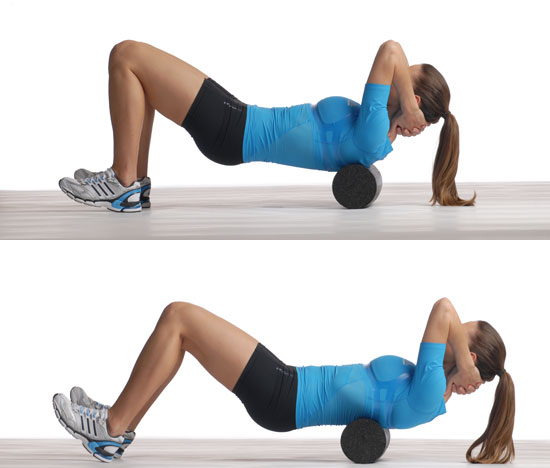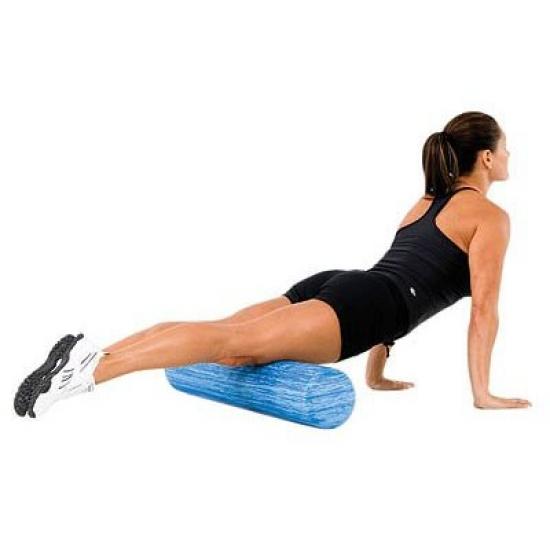Foam Rolling

Have you ever been in the stretching area of your local Anytime and noticed a circular piece of foam just sitting there? We have too! You don't have to spend thousands of dollars with your local massage therapist to get a good deep tissue treatment. Today, we dig into what a foam roller is, how to use it, and why it's beneficial for your workout routine!
What Is Foam Rolling?
Foam rolling is a self-myofascial release technique used to alleviate muscle pain and increase blood flow. It uses body weight to generate direct pressure to the "knots" or trigger points in the body. Often thought of as an "athlete's only" piece of equipment, the foam roller is a great tool for anyone needing to release muscle tension (and we all have a bit of muscle tension from sitting too long, exercise, or general tension). Imagine using a rolling pin to roll out lumps in bread dough and you'll get the picture.
What Are The Benefits?
Rolling is beneficial before and after your workout. Foam rolling prior to a workout can help decrease muscle density and allow for a better warm-up. Rolling after a workout can aid in recovery from a strenuous exercise. Other benefits of self-myofascial release include:
- Improvement in joint range of motion
- Ease of muscle soreness and joint stress
- Help in maintaining functional muscular length
The Product
The roller is a foam cylinder and it comes in a variety of sizes. Most commonly in the gym setting, you'll see a longer roller, measuring 36 inches with a 6-inch diameter. The density of the foam can vary as well. If you're new to foam rolling or have particularly tight muscles or trigger points, opt for a softer foam roll. Typically, white rollers are softer, while blue or black rollers tend to be firmer.
Key Points For Foam Rolling
Rolling can be effective for many muscles, including calves, hamstrings, glutes, quadriceps, hip flexors, latissimus dorsi, and the thoracic spine. Place the foam roller under each muscle group and roll, long strokes, for 60 seconds until a tender area is found. Once a knot is found, maintain pressure on the knot or trigger point for 30 to 60 seconds by moving back and forth over that surface area. Follow up by performing a stretch for each muscle group you just have rolled for maximal benefit.
Easy Foam Roller Routine
Try these simple foam roller exercises and stretches to target areas where most everyone could use a little love: the upper back, glutes, and thighs.

Foam Roller: Thoracic Spine (Upper Back)
- Begin with the foam roller underneath your shoulder blades.
- Place your hands behind your head for support, or cross your arms over your chest.
- Lift your hips up slightly off the ground, maintain a slight curve in the low back (almost like you are performing a small crunch).
- Use your feet to push forward and backward to roll out the upper back, rolling from the shoulder blades to the mid-back.
Stretch: Quadruped Cat/Cow
- Begin on your hands and knees with your back in a neutral position.
- Inhale and lift your chin and tailbone toward the sky, creating an arch in the back.
- Exhale and tuck your chin and tailbone toward the ground, rounding out the spine.

Foam Roller: Glutes
- Begin by sitting on the foam roller, knees bent and feet on the ground. Shift slightly to the right and begin to roll up and down the length of the glute. Switch sides.
Stretch: Supine Knees To Chest
- Lie on your back and draw both knees into your chest.
- Keep your head and shoulders grounded to the floor.

Foam Roller: Quadriceps
- Begin with the foam roller underneath your quadriceps (fronts of the thighs).
- Lift your legs slightly off the ground and place the weight of your upper body on your forearms.
- Push with your arms to roll out the quadriceps by moving forward and backward from pelvic bone to the knee.
Stretch: Standing Quadriceps Stretch
- Stand on your left leg and bring the right foot toward your glutes.
- With your right hand, grab onto your right foot, keeping your knee pointed toward the ground and legs close together.
- Switch sides.